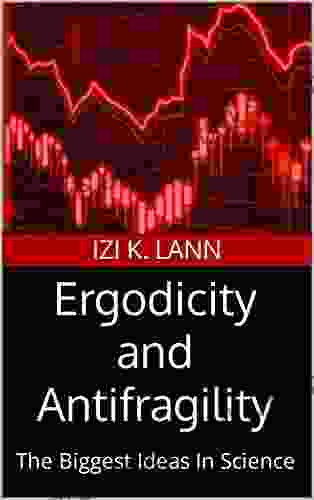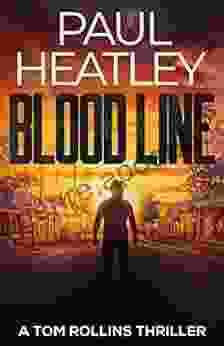Ergodicity and Antifragility: The Biggest Ideas in Science

In his book, Ergodicity and Antifragility: The Biggest Ideas in Science, Nassim Nicholas Taleb argues that the traditional scientific method is based on a flawed assumption: that the future will be like the past. This assumption, which Taleb calls "ergodicity," leads to a number of false s, including the belief that we can predict the future by studying the past.
Taleb argues instead for an "antifragile" approach to science. Antifragile systems are those that become stronger when exposed to stress. They are not immune to harm, but they are able to withstand shocks and recover quickly. In contrast, fragile systems are those that are easily damaged by stress. They are like glass, which can be shattered by a single blow.
4 out of 5
| Language | : | English |
| File size | : | 1300 KB |
| Text-to-Speech | : | Enabled |
| Screen Reader | : | Supported |
| Enhanced typesetting | : | Enabled |
| Word Wise | : | Enabled |
| Print length | : | 10 pages |
Taleb identifies a number of antifragile systems in nature, including the human immune system, the stock market, and the Internet. He argues that these systems are able to withstand shocks because they are decentralized and have multiple feedback loops. This makes them difficult to predict, but also makes them more resilient.
Taleb's ideas have been controversial, but they have also been influential. They have been applied to a wide range of fields, including economics, finance, and psychology. And they have helped to change the way we think about the future.
The Problem with Ergodicity
The traditional scientific method is based on the assumption that the future will be like the past. This assumption is known as ergodicity. Ergodicity is a powerful tool, and it has led to many important scientific discoveries. However, it is also a flawed assumption.
There are a number of reasons why the future is not like the past. First, the world is constantly changing. New technologies are being developed, new ideas are being discovered, and new events are happening all the time. This means that the future is always uncertain.
Second, the world is complex. There are a vast number of factors that can influence the future, and it is impossible to predict all of them. This makes it difficult to make accurate predictions about the future.
Third, the world is nonlinear. This means that small changes can have large effects. For example, a small change in the weather can lead to a large change in the stock market. This makes it difficult to predict the future, because it is impossible to know how small changes will affect the future.
The Benefits of Antifragility
Antifragile systems are those that become stronger when exposed to stress. They are not immune to harm, but they are able to withstand shocks and recover quickly. In contrast, fragile systems are those that are easily damaged by stress. They are like glass, which can be shattered by a single blow.
Taleb identifies a number of antifragile systems in nature, including the human immune system, the stock market, and the Internet. He argues that these systems are able to withstand shocks because they are decentralized and have multiple feedback loops. This makes them difficult to predict, but also makes them more resilient.
Antifragility is a valuable property for any system. It allows systems to survive and thrive in an uncertain and ever-changing world. By understanding antifragility, we can design systems that are more resilient and better able to withstand shocks.
Applications of Antifragility
The ideas of antifragility have been applied to a wide range of fields, including economics, finance, and psychology. In economics, antifragility is used to explain why some economies are more resilient to shocks than others. In finance, antifragility is used to design investment strategies that are less risky. And in psychology, antifragility is used to help people develop more resilient personalities.
The ideas of antifragility are still being developed, but they have already had a major impact on our understanding of the world. They have helped us to understand why some systems are more resilient than others, and they have given us new tools to design more resilient systems.
Ergodicity and antifragility are two of the biggest ideas in science. Ergodicity is the assumption that the future will be like the past. Antifragility is the property of systems that become stronger when exposed to stress.
The traditional scientific method is based on ergodicity, but this assumption is flawed. The future is not like the past. It is uncertain, complex, and nonlinear. This makes it difficult to predict the future.
Antifragile systems are those that can withstand shocks and recover quickly. They are decentralized and have multiple feedback loops. This makes them difficult to predict, but also makes them more resilient.
The ideas of antifragility have been applied to a wide range of fields, including economics, finance, and psychology. They have helped us to understand why some systems are more resilient than others, and they have given us new tools to design more resilient systems.
Ergodicity and antifragility are two of the most important ideas in science. They have changed the way we think about the future, and they have given us new tools to design more resilient systems.
4 out of 5
| Language | : | English |
| File size | : | 1300 KB |
| Text-to-Speech | : | Enabled |
| Screen Reader | : | Supported |
| Enhanced typesetting | : | Enabled |
| Word Wise | : | Enabled |
| Print length | : | 10 pages |
Do you want to contribute by writing guest posts on this blog?
Please contact us and send us a resume of previous articles that you have written.
 Book
Book Novel
Novel Page
Page Chapter
Chapter Text
Text Story
Story Genre
Genre Reader
Reader Library
Library Paperback
Paperback E-book
E-book Magazine
Magazine Newspaper
Newspaper Paragraph
Paragraph Sentence
Sentence Bookmark
Bookmark Shelf
Shelf Glossary
Glossary Bibliography
Bibliography Foreword
Foreword Preface
Preface Synopsis
Synopsis Annotation
Annotation Footnote
Footnote Manuscript
Manuscript Scroll
Scroll Codex
Codex Tome
Tome Bestseller
Bestseller Classics
Classics Library card
Library card Narrative
Narrative Biography
Biography Autobiography
Autobiography Memoir
Memoir Reference
Reference Encyclopedia
Encyclopedia Jan Philipp Sendker
Jan Philipp Sendker Patricia Bage
Patricia Bage Robert Shea
Robert Shea Peter Avery
Peter Avery Yi Wang
Yi Wang Skylar Finn
Skylar Finn Michael W
Michael W Lauren Barnes
Lauren Barnes Lisa Leigh Patel
Lisa Leigh Patel Riccardo Bernardini
Riccardo Bernardini Summer Louise Truswell
Summer Louise Truswell Rene Schreiber
Rene Schreiber Linda Hogan
Linda Hogan Rafal Ganowski
Rafal Ganowski Mande Matthews
Mande Matthews Linda Watanabe Mcferrin
Linda Watanabe Mcferrin Robert Kelchen
Robert Kelchen Mary Jo Salter
Mary Jo Salter Matthew Masterson
Matthew Masterson Andrew Sanders
Andrew Sanders
Light bulbAdvertise smarter! Our strategic ad space ensures maximum exposure. Reserve your spot today!

 Pat MitchellUnlock Your Trumpet Potential: Master 300 Progressive Sight Reading Exercises
Pat MitchellUnlock Your Trumpet Potential: Master 300 Progressive Sight Reading Exercises
 Edward BellSkinny Island: More Tales of Manhattan - A Literary Odyssey through the Heart...
Edward BellSkinny Island: More Tales of Manhattan - A Literary Odyssey through the Heart... Quincy WardFollow ·3.7k
Quincy WardFollow ·3.7k Winston HayesFollow ·6.4k
Winston HayesFollow ·6.4k Brady MitchellFollow ·12k
Brady MitchellFollow ·12k Clarence BrooksFollow ·18.1k
Clarence BrooksFollow ·18.1k Theodore MitchellFollow ·5.5k
Theodore MitchellFollow ·5.5k Efrain PowellFollow ·3.9k
Efrain PowellFollow ·3.9k Abe MitchellFollow ·19.5k
Abe MitchellFollow ·19.5k Sean TurnerFollow ·17.6k
Sean TurnerFollow ·17.6k

 Finn Cox
Finn CoxCarmen Suite For Flute Quartet (G Alto Flute) ( Carmen...
Experience the Magic of...

 Andy Cole
Andy ColeUncover Hidden Truths: A Comprehensive Guide to Detecting...
: The Silent...

 Ken Simmons
Ken SimmonsUnleash Your Potential: Transform Frustration and...
Are you tired of feeling...

 Rick Nelson
Rick NelsonHard To Kill: A Gripping Thriller That Will Keep You on...
Tom Rollins is a...

 Ivan Turner
Ivan TurnerUnleash the Power of Your Breath: Discover Breath...
In the tapestry of life, where stress and...
4 out of 5
| Language | : | English |
| File size | : | 1300 KB |
| Text-to-Speech | : | Enabled |
| Screen Reader | : | Supported |
| Enhanced typesetting | : | Enabled |
| Word Wise | : | Enabled |
| Print length | : | 10 pages |










